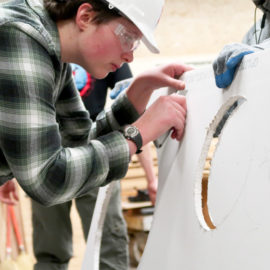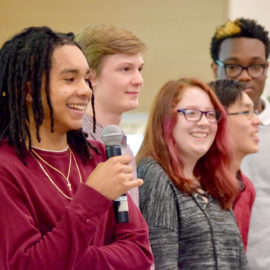Our state faces many challenges. Oregon has a low graduation rate, Oregon employers are face pressing shortages for their most important jobs, and Oregon has persistent inequities in its schools and workplaces that affect students' access to great careers. However, there are many opportunities for improvement. Career learning, both in the community and in Career Technical Education classes, is proven to help students graduate, continue their education after high school, and find their footing in the world of work.
Challenges
For the past two years, Oregon’s high school graduation rate has been steadily increasing. The Oregonian reported that 79 percent of students in the class of 2018 earned diplomas within four years, achieving the best graduation rate in state history. That’s a gain of 4 percentage points since 2016, but the latest data still leaves Oregon’s graduation rate ranked at No. 49 in the nation.
Oregon has persistent inequities in its schools and workplaces that affect students' access to great careers. In 2014, one in three Latino students in Oregon dropped out of high school and didn’t earn a diploma. Rex Putnam High School, a school in one of PWA’s partner districts, North Clackamas, worked hard to boost graduation rates for its Latino students. In 2017, 93% of Putnam High’s Latino students graduated. This was due to a concerted effort to implement a variety of programs and initiatives to promote student success. Career education was one part of the equation. The school’s districtwide career center provides career-technical courses and a summer school program.
Another partner of PWA, the Portland Public School district, saw a nearly 6% increase in the number of Black and African American students graduating in 2018. 70.6% of the districts’ Black and African American students graduated, which is more than 2 points above the statewide rate. The district credits their overall improved graduation rates in part to an increased investment in Career & Technical Education, which has increased the number of career-focused learning opportunities available to students.
In the workforce, Oregon’s tech sector, for example, remains predominantly white and male, as it does throughout the nation. According to the U.S. Census, 31% of Oregon tech workers are women, only 2% are African American and 6% are Hispanic. “By excluding large categories of people, and by paying some groups much more than others, the sector is effectively restricting access to well-paying jobs and increasing disparities in Oregon’s economy,” The Oregonian reported.
Career Exploration Makes a Difference
However, career exploration for high school students is making a difference in fighting against the state’s challenges. In Oregon, students enrolled in Career Technical Education programs are 15% more likely to graduate from high school in four years than students who do not take the courses, according to the Oregon Department of Education.
Further, the “2019 Success in CTE report” notes that community partners are vital for helping schools offer real-world relevance. “America’s tepid approach (to career education) may stem from the erroneous belief that CTE is an alternative to rigorous academics,” the report reads. “In fact, modern, high-quality CTE programs only complement strong, college-preparatory academics, while deeply engaging students. Such strong programs open multiple pathways to learning, degrees, and credentials after high school—and thus, new and better choices for students.” Community partners are vital, the report notes, for helping schools offer real-world relevance.
Plenty of Jobs for the Well Prepared
Job growth is on the rise in the Portland region, yet many employers say they have trouble finding qualified candidates for job openings. In some cases, worker shortages can even be bad news for Oregon’s economy. In 2018, for example, Columbia Steel Casting in North Portland had 50 open positions and couldn’t expand until it filled those positions.
A report by the State of Oregon Employment Department, found that at any given time in 2018, Oregon’s private employers had 58,000 job vacancies. They reported difficulty filling 33,000 (or 57%) of those job vacancies. In addition, the report found that in the “nearly decade-long stretch of annual job growth… a lack of applicants has been the greatest challenge businesses face in filling job vacancies.”
The skills gap is an ongoing and persistent problem. The Columbia-Willamette Workforce Collaborative “Workforce Report” in 2016 stated: “Addressing the mismatch between the skills of available workers and current and projected jobs is the fundamental challenge facing the region’s workforce efforts.”
Thousands of highly skilled workers are aging in key industry sectors, which means greater opportunities for younger ones. For those with the right education and experience, this means bright prospects in a variety of industries.
Hiring Hot Spots
A 2016 report on the state of the workforce in the Portland-Vancouver region projects significant job growth in key areas such as health care (23%), construction (26.5%) and software/IT (32.5%) into the middle of the next decade.
Further, the 2018 State of Oregon Employment Department report found that health care and social assistance had the largest number of difficult-to-fill vacancies (5,500) and construction reported the largest share of all vacancies as difficult to fill (85%).
The Oregon tech market is also accelerating. According to the Oregon Employment Department, technology employment expanded by 3.1% between December 2017 and the end of 2018.
Geographically, the 2018 report found that the Portland Metro area reported the largest number of difficult-to-fill job vacancies (12,700). The East Cascades and Southwestern Oregon regions reported the largest shares of vacancies as difficult to fill, at 73 percent and 68 percent, respectively.




